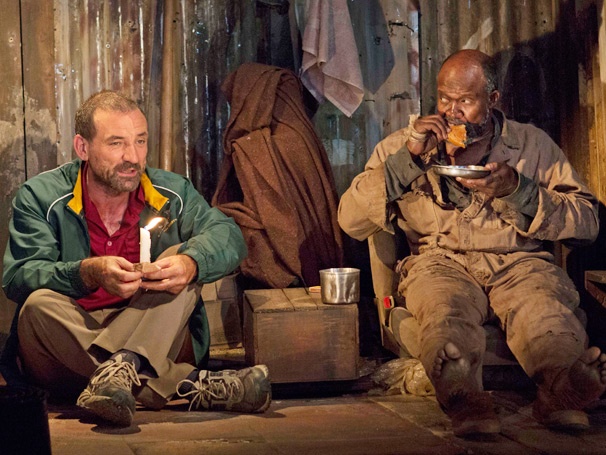The eerie graveyard setting of Athol Fugard’s play “The Train Driver” is an excellent fit for the story the play tells. The barren wasteland filled with garbage, a broken down car and a lone hut set the mood for the play, a serious and hopeless tone to match the topic of Apartheid. Like everything, Apartheid has two sides. Fugard chooses to write about the interesting white person point of view, telling the story through the eyes of a crazed train driver.
Based on a true story about how a mother jumped in front of a train killing herself and her three children, “The Train Driver” takes a solemn atmosphere from the very beginning. Roelf Visagie (Ritchie Coster) plays the maddened train driver, who has had his life destroyed by the accident. Though not at fault, he is still haunted by the image of the pulverized body of the nameless woman, “red doek” that his train hit, and he has come to the squatter camp to look for her grave.
He meets the gravedigger, Simon Hanabe (Leon Addison Brown), a black man who earns his meager living by burying the unnamed dead and marking their spots with garbage. The scattered bricks, irons, bottles and rocks lying still in the sand sadly do not act as headstones; they just mark the places where he is not to dig again, showing the little respect that the nameless dead receive. Over the next 90 minutes, the two men talk and although Hanabe never fully welcomes Roelf, he accepts him into his home after warning him that it is dangerous for him outside.

Credits to Richard Termine/Boneau/Bryan-Brown via Bloomberg
Roelf has reflective moments during the play. Unlike his rash, accented screaming and yelling at Hanabe at the beginning of the play, which is very hard to understand, these later monologues can be understood. He strikes a serious note with idea that death is the ultimate unifier. “Black man or white man…the maggots don’t care about that.” Roelf begins to understand the story from the black point of view, understanding the hopelessness and despair that the black underclass felt. His anger subsides and he no longer hates the nameless and unwanted woman.
Coster and Brown both do above average jobs of acting their role. Brown always looks and speaks with respect to Coster, who is playing the white man in the play. However with his short and abrupt dialogue, not much is revealed about him, which is disappointing since he is one of only two characters in the play. He is a simple gravedigger who needs his spade to survive. Coster on the other hand is exploding with emotion. He curses throughout his rampages way too often, but his profanity just illustrates the effect that the accident had on him. At first he is raged, hysterical and hard to understand. But as Coster’s character begins to understand and empathize with the hopeless, the harsh wrinkles and bright red color on his face fade to a pale white. His expressions relax, and he can talk about the nameless “red doek” calmly and in a reflective manner.

Credits to Richard Termine/Boneau/Bryan-Brown via Bloomberg
Since there is only a two-man cast, the story often feels like a monologue. It takes a while to get going because it takes some time before the viewer starts understanding Coster’s outbursts. But once that obstacle is overcome, both the dialogue and script of the play overtake the viewer and shows the true power of the play. There is nothing on stage to distract the viewer from the conversation and the well-delivered lines. The costumes were tattered clothes, ripped and nothing eye catching at all. The lighting was simple: a bright light for day and a blue moonlight for night. Everything was motionless in the background to allow the viewer to focus on the intensity of the dialogue between Hanabe and Roelf. This way the viewer walks away with a powerful message about the struggle and hopelessness of Apartheid, but also how in the end, we are all the same.


Fascinating comment that the play often feels like a monologue –despite it having two characters. Why so?
I felt this way because much of the dialogue goes to Roelf rather than Simon. Simon’s lines are short and abrupt and do not reveal much about him. Roelf, however, has many points in the play where he talks about how he is feeling and his thoughts about what has happened. His character is developed and we can see his change throughout the play. Even though Simon is there, to me, he reinforces Roelf’s ideas and dialogue, further developing Roelf’s character rather than his own.